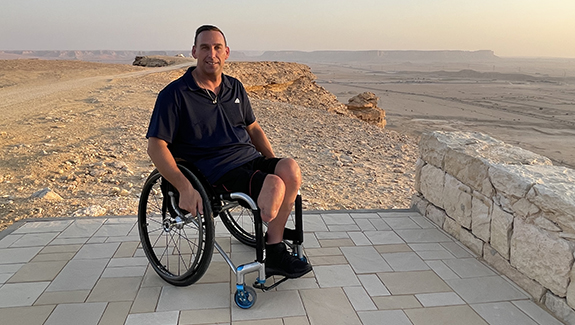Planning an Accessible Family Vacation
Being in a wheelchair hasn’t kept Shaun Gash from exploring the world with his family. Discover how he and his wife Dawn have planned and enjoyed vacations with their three children throughout the years.

Learn the keys to planning an accessible and successful family vacation.
This article is based on interviews conducted by Sue Lennon. Sue is a nurse, therapist, educator, and coach with nearly three decades of experience in oncology nursing – including urology and stoma care. She values nurse-patient communication and provides truly holistic care.
Vacations with family usually involve a lot of planning, but they often result in priceless memories and closer bonds. For parents with spinal cord injuries, the payoffs of family vacations are the same, but extra planning is required.
In 1991, Shaun Gash, who lives in the UK, was in a serious car crash. The accident left him a T5/T6 paraplegic at age 20. Over the years, Shaun and his family have had the opportunity to go on several wonderful trips, gaining valuable knowledge about planning enjoyable and accessible family vacations.
Living with a spinal cord injury and planning a vacation
When you have a spinal cord injury (SCI), vacation planning is crucial – to ensure that the trip will be both fun and safe. Shaun and his wife have learned that anticipating needs, gathering information, and making arrangements well in advance are all very important.
Toilet and shower facilities are a top concern, so when it comes to lodging, Shaun always asks about the bathroom layout and the accessibility of bathroom fixtures. He has also had very different experiences, depending on where he and his family traveled. Shaun likes going to the United States because he doesn’t have to worry about the availability of accessible toilets. “(In England), you have to ask for more information from your hotel or wherever you’re staying to ensure the facilities are right,” he says. “Can I use the shower? Can I use the toilet? Those are two fundamental things for me.”
Another key aspect for the couple is ensuring that they have a separate, adjoining hotel room for the kids – so it’s easy to go back and forth. Unfortunately, this can increase costs, but both Shaun and Dawn feel it’s important. “We make sure that the two rooms are adjoining, especially with all the time we spend in the hotel,” says Shaun.
Flying “under the radar”
Shaun’s family has taken several vacations and other trips involving air travel. During a flight, he has two priorities: using an intermittent catheter without being noticed and avoiding a urinary tract infection. For his ongoing success in both areas, he credits the latest innovations in catheter design along with an essential item: a blanket.
Shaun feels comfortable going anywhere on a plane, as long as he has a blanket. “I was flying back from LA (to the UK) and had passengers on one side and in front, and they didn't have a clue that I (was using) a catheter,” says Shaun. He uses the VaPro Plus Pocket™ No Touch Intermittent Catheter with a protective tip and sleeve and an integrated urine collection bag. “Of course, you have to wash your hands, but I don’t have to worry about (creating) a sterile environment; because of the package itself, you’re already protected,” says Shaun. “I am confident enough to (use the catheter on a plane) and know I won’t get an infection.”
Shaun offers some final words of advice for vacationing – with family, with friends, or by yourself – when you have a spinal cord injury. “Plan everything,” he emphasizes. “Plan where you go in advance and make sure that the facilities are there for you... because then everything else falls into place.”
Financial Disclosure: Shaun received compensation from Hollister Incorporated for his contributions to this article.
The testimonials, statements and opinions presented are applicable to the person depicted. These testimonials are representative of that person’s experiences, but the exact results and experience will be unique and individual to each person.




